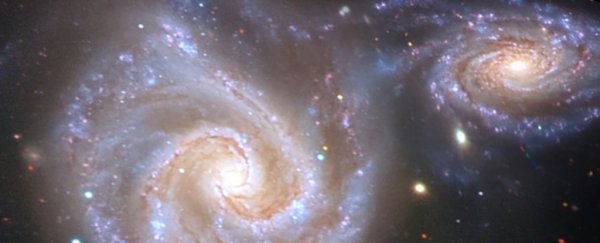A new technique for determining the ages of stars in the Milky Way has given us tighter constraints for an ancient galactic collision.
By closely examining the internal oscillations and chemical composition of 95 red giant stars, a team of astronomers led by the University of Birmingham in the UK has determined that the Milky Way's biff with a mysterious small galaxy known as Gaia-Enceladus, or the Gaia Sausage, took place around 10 billion years ago.
They also found that many of the stars in the Milky Way had already formed prior to this merger; now, these original stars can mostly be found in the thick disk of the galaxy, the larger of the Milky Way's two disk structures.
"The chemical composition, location and motion of the stars we can observe today in the Milky Way contain precious information about their origin," explained astronomer Josefina Montalbán of the University of Birmingham in the UK.
"As we increase our knowledge of how and when these stars were formed, we can start to better understand how the merger of Gaia-Enceladus with the Milky Way affected the evolution of our galaxy."
The Milky Way has had a pretty violent time over the 13.6 billion years or so since it formed. It has repeatedly gobbled up smaller galaxies, appropriating their stars as its own.
The ongoing Gaia survey, which is mapping the Milky Way in 3D, has revealed these collisions in the motions of the stars; and, as far as we can tell so far, the biggest of the galaxies slurped up by the Milky Way was the Gaia Sausage.
For more granular detail about this incident, though, you need more than the motions of the stars, as revealing as those can be. Knowing the ages and chemical compositions can help too, since they can help determine where the stars were born.
A star's chemical composition can help work out its age - younger stars have more heavy elements than older ones, or higher metallicity, since metals didn't exist before stars came along and forged them via nuclear fusion and supernova explosions. These compositions are determined using spectroscopy, looking for changes in specific wavelengths that indicate certain elements are present.
Spectroscopy is a pretty great tool; but for even higher accuracy, the research team turned to asteroseismology.
Asteroseismology is the study of the oscillation frequencies of stars, or pulsations in their light intensity driven by internal acoustic waves. These oscillations are closely linked to the properties of the star's interior, such as its density and acoustic profile; in turn, these are related to the star's mass and age.
Now-retired planet-hunting telescope Kepler was optimized to search for changes in star brightness, since that is one way we can detect exoplanets orbiting them. It collected asteroseismological data on a whole bunch of stars; from these, Montalbán and her team picked a bunch of red giant stars with low metallicity, since these are long-lived and intrinsically bright, which makes them excellent for mapping star ages.
They then conducted an asteroseismological analysis of 95 of them, focusing on the individual stars instead of averaging out their properties.
The spectroscopy revealed that some of the stars originated in the Gaia Sausage, and the asteroseismology revealed these were all around the same age, about 10 billion years old, or slightly younger, than the stars that formed right here in the Milky Way.
This suggests the Milky Way had already formed a good number of its stars, and was doing so efficiently, before the merger with the Gaia Sausage. This supports previous findings that the Milky Way-Gaia Sausage infall took place around 10 billion years ago, the researchers said.
"We have shown the huge potential of asteroseismology in combination with spectroscopy to deliver precise, accurate relative ages for individual, very old, stars," said astronomer Andrea Miglio, of the University of Bologna in Italy.
"Taken together, these measurements contribute to sharpen our view on the early years of our Galaxy and promise a bright future for Galactic archeoastronomy."
The research has been published in Nature Astronomy.
